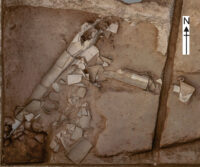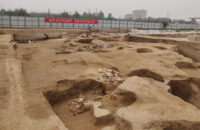 The remains of a 3,000-year-old earthenware drainage pipe have been unearthed in Xi’an City, capital of northwest China’s Shaanxi Province. The drainage pipe was made of four cylindrical pipes 10 inches in diameter linked together to form a section 10 feet long. It was discovered in an excavation of the ancient site of Haojing which dates to the Western Zhou Dynasty (1045 B.C. – 771 B.C.).
The remains of a 3,000-year-old earthenware drainage pipe have been unearthed in Xi’an City, capital of northwest China’s Shaanxi Province. The drainage pipe was made of four cylindrical pipes 10 inches in diameter linked together to form a section 10 feet long. It was discovered in an excavation of the ancient site of Haojing which dates to the Western Zhou Dynasty (1045 B.C. – 771 B.C.).
Haojing was one of the twin capitals of the Western Zhou Dynasty. It was located on the east bank of the Feng River; the other capital, Fenghao, was on the west bank. Haojing was founded by King Wu of Zhou (r. 1046-1043 B.C.) and contained the royal palace the administrative center of government. Fenghao contained the Zhou Dynasty ancestral shine and formal gardens.
 The archaeological site of Haojing today covers 3.5 square miles. The foundations of a dozen Western Zhou rammed earth buildings have been excavated since the 1980s. Since the spring of 2019, archaeologists have focused their attentions on the foundation of Building No. 14, one of the larger rammed earth building bases at the site. So far they have unearthed 13,000 square feet of rammed earth remains, including rammed earth foundations and walls up to five feet thick. The 10-foot pipe was found in the foundation.
The archaeological site of Haojing today covers 3.5 square miles. The foundations of a dozen Western Zhou rammed earth buildings have been excavated since the 1980s. Since the spring of 2019, archaeologists have focused their attentions on the foundation of Building No. 14, one of the larger rammed earth building bases at the site. So far they have unearthed 13,000 square feet of rammed earth remains, including rammed earth foundations and walls up to five feet thick. The 10-foot pipe was found in the foundation.
The rammed earth foundation of Haojing No. 14 building is generally slightly rectangular in the north-south direction, with a length of about 53 meters and a width of about 34 meters, with a total area of more than 1,800 square meters. It is a large, high-level building. The southern and central western parts of the building site are relatively well preserved. On top of the rammed earth platform, there are 8 rammed earth wall foundations arranged in an east-west direction. There are 8 houses in total, of which 2 are larger in the middle, with the main room (hall), and 3 on both sides. The house is narrow and is a wing room, which is the same width as the wing room of the Hogyeong West Friday Palace, which was excavated in the mid-1980s. It’s roughly the same.
A three-meter-long pottery drainage pipe was found on the south-central edge of the building site. It is made up of four circular pottery pipes, one large at one end and one small at the other end. The pottery water pipe is decorated with rope pattern on the outside, the inside is plain, the diameter is about 25 cm, and the length varies. It is the best-preserved drainage pipe found at the site.
After reading all the articles here, I think I am at last getting a handle on Chinese history!
That concretion appears to lie over another piece of pipe – was the pipe relayed at some point.
And what are those tray-like tiles? Roof tiles?
“Roof tiles”? :confused: Of course, these sanitation pipe segments were “relayed”. OK, it may well be that I am looking somewhere else 😉
—-
Apparently, underground relayed clay pipes were a rather “middle” Asian invention, although it may be hard to tell, who was first.
Underground clay pipes for sanitation and water supply, however, were –Millennia ago– common in what today is Pakistan as in the Minoan “Palaces” in the Mediterranean, including a flush toilet. In Akrotiri, Santorini -i.e. before the mishap with the volcano- people seem to have had something similar.
Much later, the “Ancient Greeks of Athens and Asia Minor also used an indoor plumbing system, used for pressurized showers”.